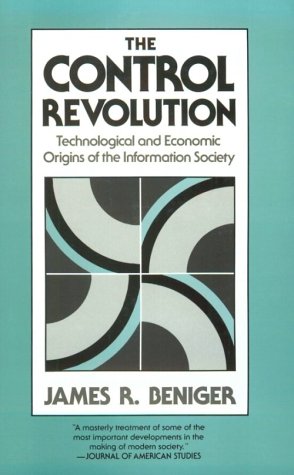James R. Beniger: The Control Revolution: Technological and Economic Origins of the Information Society (1986)
Filed under book | Tags: · advertising, agriculture, bureaucracy, computing, cybernetics, economy, energy, history of technology, industrial revolution, industry, information society, management, mass media, radio, society, technology, telegraphy, telephone, television, transport

“James Beniger traces the origin of the Information Society to major economic and business crises of the past century. In the United States, applications of steam power in the early 1800s brought a dramatic rise in the speed, volume, and complexity of industrial processes, making them difficult to control. Scores of problems arose: fatal train wrecks, misplacement of freight cars for months at a time, loss of shipments, inability to maintain high rates of inventory turnover. Inevitably the Industrial Revolution, with its ballooning use of energy to drive material processes, required a corresponding growth in the exploitation of information: the Control Revolution.
Between the 1840s and the 1920s came most of the important information-processing and communication technologies still in use today: telegraphy, modern bureaucracy, rotary power printing, the postage stamp, paper money, typewriter, telephone, punch-card processing, motion pictures, radio, and television. Beniger shows that more recent developments in microprocessors, computers, and telecommunications are only a smooth continuation of this Control Revolution. Along the way he touches on many fascinating topics: why breakfast was invented, how trademarks came to be worth more than the companies that own them, why some employees wear uniforms, and whether time zones will always be necessary.”
Publisher Harvard University Press, 1986
ISBN 0674020766, 9780674020764
493 pages
via babyalanturing
Review (JoAnne Yates, The Journal of Interdisciplinary History, 1988)
Review (Krishan Kumar, Journal of American Studies, 1988)
Review (Kirkus Reviews)
Book-inspired website
Publisher
PDF (16 MB, updated on 2016-6-16)
Comment (0)Jonathan Sterne: The Audible Past: Cultural Origins of Sound Reproduction (2003)
Filed under book | Tags: · history of technology, listening, media technology, music, music history, phonograph, radio, sound, sound recording, technology, telegraphy, telephone

“The Audible Past explores the cultural origins of sound reproduction. It describes a distinctive sound culture that gave birth to the sound recording and the transmission devices so ubiquitous in modern life. With an ear for the unexpected, scholar and musician Jonathan Sterne uses the technological and cultural precursors of telephony, phonography, and radio as an entry point into a history of sound in its own right. Sterne studies the constantly shifting boundary between phenomena organized as “sound” and “not sound.” In The Audible Past, this history crisscrosses the liminal regions between bodies and machines, originals and copies, nature and culture, and life and death.
Blending cultural studies and the history of communication technology, Sterne follows modern sound technologies back through a historical labyrinth. Along the way, he encounters capitalists and inventors, musicians and philosophers, embalmers and grave robbers, doctors and patients, deaf children and their teachers, professionals and hobbyists, folklorists and tribal singers. The Audible Past tracks the connections between the history of sound and the defining features of modernity: from developments in medicine, physics, and philosophy to the tumultuous shifts of industrial capitalism, colonialism, urbanization, modern technology, and the rise of a new middle class.
A provocative history of sound, The Audible Past challenges theoretical commonplaces such as the philosophical privilege of the speaking subject, the visual bias in theories of modernity, and static descriptions of nature. It will interest those in cultural studies, media and communication studies, the new musicology, and the history of technology.”
Publisher Duke University Press, 2003
ISBN 082233013X, 9780822330134
450 pages
via nutzenberg
Reviews: James P. Kraft (American Historical Review), Karin Bijsterveld (Technology and Culture).
PDF (updated on 2022-12-7)
Comment (0)K. G. Beauchamp: Exhibiting Electricity (1997)
Filed under book | Tags: · 1800s, 1900s, electricity, engineering, exhibition, history of science, history of technology, machine, science, technology, telegraphy

“This unusual book traces the history of public and technical exhibitions, from their origins in the late 18th century to present day, and, particularly, how they have reflected the progress of science and technology (especially electrical technology). Not only does the author show how electrical innovation and manufacture have been presented to the wider public through this period, but he also shows how the exhibitions themselves have required technological advice. It is through this combination of roles that the importance of these exhibitions within scientific and technological advance can be understood.”
Publisher Institution of Electrical Engineers, 1997
IEEE History of Technology Series, Volume 21
ISBN 0852968957, 9780852968956
352 pages
review (Bernard S. Finn, Technology and Culture)
review (Iwan Rhys Morus, The British Journal for the History of Science)

